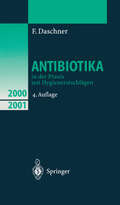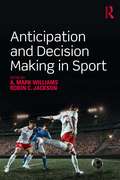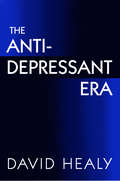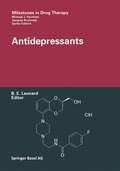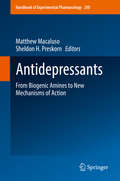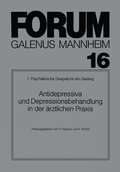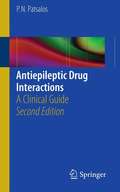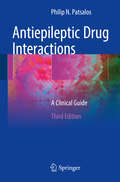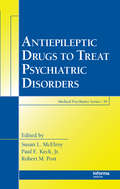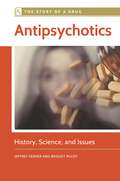- Table View
- List View
Anti-Work: Psychological Investigations into Its Truths, Problems, and Solutions
by George M. AlligerThe first book to delineate anti-work in a systematic fashion by identifying and compiling positions from a wide spread of literature, Anti- Work: Psychological Investigations into Its Truths, Problems, and Solutions defines the tenets of anti-work, reviews them from a psychological and historical point of view, and offers solutions to aid the average person in his or her struggle with work. Anti-work thinkers have vigorously argued that work entails a submission of the human will that is constraining and even ultimately damaging. The author has refined 18 tenets of anti-work from the literature, which range from the suggestion that all jobs are bad, to the remarkable ability of modern capitalist enterprises to build "job engagement" among workers, to the proposal of alternative work- deemphasized worlds. Anti-Work begins with a discussion of these tenets, in particular the submission of the will required by work, followed by an overview of topics such as worker resistance, merit, and precarious work. The second part of the book unfolds various possible human responses to the work problem, such as detachment, thinking while working, and right livelihood. In the third part, several lessons about anti-work are drawn from parables, koans, and tales. Discussions of cults and work, working from home, unions, and cooperatives, as well as lessons from Buddhism, Hinduism, and Christianity, offer additional perspectives on the topic of work and provide guidance on developing a helpful attitude toward it. By highlighting the tensions that exist between anti-work and pro-work positions, the book provides new ways to view and plan life, and will give thought- provoking and valuable insights for students, instructors, and practitioners in industrial and organizational psychology and related fields, as well as all people who have worked, will work, have never worked, or will never work.
Antibiotika in der Praxis mit Hygieneratschlägen
by F. DaschnerDieses Buch ist die Praxisversion des Taschenbuches Antibiotika am Krankenbett. Es befaßt sich ausschließlich mit den Erkrankungen und Präparaten, die für die ärztliche Praxis von Bedeutung sind. Die Neuauflage informiert über die neuesten Präparate und deren Wirkungsspektrum. Die Antibiotikatherapie sämtlicher wichtiger Infektionen wird in tabellarischer Form kurz und übersichtlich dargestellt. Weiterhin werden umweltschonende und kostensparende Hygieneratschläge für die ärztliche Praxis gegeben. Die Besonderheiten des Buches sind das bewährte Kittel-Taschenbuchformat und die kurze, übersichtliche Darstellung, die es ermöglicht, die wichtigsten Informationen rasch nachzuschlagen.
Anticipation and Decision Making in Sport
by A. Mark Williams Robin C. JacksonThe ability to anticipate and make accurate decisions in a timely manner is fundamental to high-level performance in sport. This is the first book to identify the underlying science behind anticipation and decision making in sport, enhancing our scientific understanding of these phenomena and helping practitioners to develop interventions to facilitate the more rapid acquisition of the perceptual-cognitive skills that underpin these judgements. Adopting a multidisciplinary approach — encompassing research from psychology, biomechanics, neuroscience, physiology, computing science, and performance analysis — the book is divided into three sections. The first section provides a comprehensive analysis of the processes and mechanisms underpinning anticipation and skilled perception in sport. In the second section, the focus shifts towards exploring the science of decision making in sport. The final section is more applied, outlining how the key skills that impact on anticipation and decision making may be facilitated through various training interventions. With chapters written by leading experts from a vast range of countries and continents, no other book offers such a synthesis of the historical development of the field, contemporary research, and future areas for investigation in anticipation and decision making in sport. This is a fascinating and important text for students and researchers in sport psychology, skill acquisition, expert performance, motor learning, motor behaviour, and coaching science, as well as practicing coaches from any sport.
Anticipation and Decision Making in Sport
by A. Mark Williams Robin C. JacksonThe ability to anticipate and make accurate decisions in a timely manner is fundamental to high-level performance in sport. This is the first book to identify the underlying science behind anticipation and decision making in sport, enhancing our scientific understanding of these phenomena and helping practitioners to develop interventions to facilitate the more rapid acquisition of the perceptual-cognitive skills that underpin these judgements. Adopting a multidisciplinary approach — encompassing research from psychology, biomechanics, neuroscience, physiology, computing science, and performance analysis — the book is divided into three sections. The first section provides a comprehensive analysis of the processes and mechanisms underpinning anticipation and skilled perception in sport. In the second section, the focus shifts towards exploring the science of decision making in sport. The final section is more applied, outlining how the key skills that impact on anticipation and decision making may be facilitated through various training interventions. With chapters written by leading experts from a vast range of countries and continents, no other book offers such a synthesis of the historical development of the field, contemporary research, and future areas for investigation in anticipation and decision making in sport. This is a fascinating and important text for students and researchers in sport psychology, skill acquisition, expert performance, motor learning, motor behaviour, and coaching science, as well as practicing coaches from any sport.
Anticipation and Medicine: A Critical Analysis of the Science, Praxis and Perversion of Evidence Based Healthcare (Concepts for Critical Psychology)
by Owen DempseyAnticipation in Medicine: A Critical Analysis of the Science, Praxis and Perversion of Evidence Based Healthcare looks at an aspect of healthcare rarely addressed: how the capitalist interest in diagnosis and treatment impacts upon the patient and, by extension, the system of healthcare itself. Using Lacanian structures of discourse, Dr. Owen Dempsey critiques the praxis of scientific Evidence Based Medicine (EBM) applied to anticipatory and preventive healthcare under capitalism and ultimately, what constitutes good care. This book features up-to-date case studies that combine real-life patients and the psychological impacts of anticipatory care such as cancer screening in the modern era. The book identifies the dangers of anticipatory care in medicine and provides compelling and new possibilities for progressing towards a more emancipatory conception of a less knowing, less apparently compassionate, as well as less harmful practice of health care. This is fascinating reading for academics, students and practitioners interested in critical health psychology, the practice of ‘scientific’ medicine, and the politics of health and social care.
Anticipation and Medicine: A Critical Analysis of the Science, Praxis and Perversion of Evidence Based Healthcare (Concepts for Critical Psychology)
by Owen DempseyAnticipation in Medicine: A Critical Analysis of the Science, Praxis and Perversion of Evidence Based Healthcare looks at an aspect of healthcare rarely addressed: how the capitalist interest in diagnosis and treatment impacts upon the patient and, by extension, the system of healthcare itself. Using Lacanian structures of discourse, Dr. Owen Dempsey critiques the praxis of scientific Evidence Based Medicine (EBM) applied to anticipatory and preventive healthcare under capitalism and ultimately, what constitutes good care. This book features up-to-date case studies that combine real-life patients and the psychological impacts of anticipatory care such as cancer screening in the modern era. The book identifies the dangers of anticipatory care in medicine and provides compelling and new possibilities for progressing towards a more emancipatory conception of a less knowing, less apparently compassionate, as well as less harmful practice of health care. This is fascinating reading for academics, students and practitioners interested in critical health psychology, the practice of ‘scientific’ medicine, and the politics of health and social care.
The Antidepressant Era (PDF)
by David HealyWhen we stop at the pharmacy to pick up our Prozac, are we simply buying a drug? Or are we buying into a disease as well? An account of the phenomenon of antidepressants, this book relates how depression, a disease only recently deemed too rare to merit study, has become one of the most common disorders of our day and a booming business to boot.;This book chronicles the history of psychopharmacology from its inception with the discovery of chlorpromazine in 1951 to current battles over whether these powerful chemical compounds should replace psychotherapy. An expert in both the history and the science of neurochemistry and psychopharmacology, David Healy offers a close-up perspective on early research and clinical trials, the stumbling and successes that have made Prozac and Zoloft household names. The complex story he tells, against a backdrop of changing ideas about medicine, details the origins of the pharmaceutical industry, the pressures for regulation of drug companies, and the emergence of the idea of a depressive disease. This historical and neurochemical analysis leads to a clear look at what antidepressants reveal about both the workings of the brain and the sociology of drug marketing.;Most arresting is Healy's insight into the marketing of antidepressants and the medicalization of the neuroses. Demonstrating that pharmaceutical companies are as much in the business of selling psychiatric diagnoses as of selling psychotropic drugs, he raises disturbing questions about how much of medical science is governed by financial interest.
Antidepressants: History, Science, and Issues (The Story of a Drug)
by Ann Westcot JordanThis accessible volume offers a holistic exploration of this diverse class of drugs, from medical, historical, cultural, and economic perspectives.Depression is one of the most commonly reported mental disorders, and it affects millions of Americans. A wide variety of medications are used to treat depression, many of which have become household names—Zoloft, Prozac, and Paxil among them. Because these medications have the ability to alter how people think and feel, however, physicians must weigh a number of factors when prescribing them, especially to teens. Antidepressants: History, Science, and Issues, a part of Greenwood's Story of a Drug series, offers a robust exploration of antidepressant medications that covers the historical, ethical, medical, legal, and scientific dimensions of these drugs.After an introductory case study of a person with depression and this individual's problems and successes with antidepressants, the book provides an overview of depression and its various symptoms as well as the causes, prevalence, and diagnosis of depression. Readers will gain an understanding of the neurotransmission and specific mechanisms behind the activity of antidepressant medications; the effects and applications of these drugs, plus their associated risks of misuse and abuse; and related policy and societal issues.
Antidepressants: History, Science, and Issues (The Story of a Drug)
by Ann Westcot JordanThis accessible volume offers a holistic exploration of this diverse class of drugs, from medical, historical, cultural, and economic perspectives.Depression is one of the most commonly reported mental disorders, and it affects millions of Americans. A wide variety of medications are used to treat depression, many of which have become household names—Zoloft, Prozac, and Paxil among them. Because these medications have the ability to alter how people think and feel, however, physicians must weigh a number of factors when prescribing them, especially to teens. Antidepressants: History, Science, and Issues, a part of Greenwood's Story of a Drug series, offers a robust exploration of antidepressant medications that covers the historical, ethical, medical, legal, and scientific dimensions of these drugs.After an introductory case study of a person with depression and this individual's problems and successes with antidepressants, the book provides an overview of depression and its various symptoms as well as the causes, prevalence, and diagnosis of depression. Readers will gain an understanding of the neurotransmission and specific mechanisms behind the activity of antidepressant medications; the effects and applications of these drugs, plus their associated risks of misuse and abuse; and related policy and societal issues.
Antidepressants (Milestones in Drug Therapy)
by Brian E. LeonardImportant clinical issues as the outcome of long term treatment with antidepressants, the time of onset of the antidepressant response and the limitations of the antidepressants currently available are covered in this monograph. Leading researchers in the area of clinical and experimental psychopharmacology critically assess the progress in their specialist fields. The mechanisms of action of antidepressants are considered, followed by clinical research into the role of the hypothalamic-pituitary-adrenal axis and the immune system in the biology of depression and in response to treatment. The final chapter deals with the important chemical entities now undergoing development as antidepressants. The purpose of this monograph is not only to inform but also to stimulate research into the biology of depression and the mechanisms behind the action of effective antidepressants. This monograph is of interest to psychiatrists, psychologists, pharmacologists, neuroscientists and endocrinologists.
Antidepressants: From Biogenic Amine To New Mechanisms Of Action (Handbook of Experimental Pharmacology #250)
by Matthew Macaluso Sheldon H. PreskornThis volume reviews the known neurobiology of depression and combines classic data on antidepressant treatments with modern theory on the physiology of depression. It also discusses novel mechanism of action drugs.
Antidepressiva und Depressionsbehandlung in der ärztlichen Praxis
by V. Beck M. Berger L. Demisch M. Gastpar B. Geiselmann H. Hippius G. Laakmann G. Laux M. Ortner M. Philipp A. Rothenberger E. Rüther G. Schüssler M. WiegandAntiepileptic Drug Interactions: A Clinical Guide
by Philip PatsalosAntiepileptic Drug Interactions: A Clinical Guide, Second Edition provides a pocket-sized, systematic description of the most clinically relevant drug interactions that occur between AEDs and also between AEDs and non-AEDs. AEDs are presented alphabetically and by drug class in three sections for easy access: Drug interactions between AEDs; Drug interactions between AEDs and non-AEDs: Interactions affecting AEDs; and Drug interactions between AEDs and non-AEDs: Interactions affected by AEDs. Antiepileptic Drug Interactions: A Clinical Guide, Second Edition should help physicians make more rational choices when polytherapy regimens are indicated and should be of interest to all who treat patients with epilepsy: neurologists and neurosurgeons, trainees at all levels, general practitioners and epilepsy nurse specialists.
Antiepileptic Drug Interactions: A Clinical Guide
by Philip N. PatsalosThis updated third edition of a successful book is a description of both pharmacokinetic and pharmacodynamic antiepileptic drug (AED) interactions, including details of the magnitude and mechanism of interactions, and also of drug combinations that are not associated with interactions and therefore can be coprescribed without undue concern. Presented in alphabetical order and by drug class, drug interactions that occur between AEDs and also between AEDs and non-AEDs are described in three sections: Drug interactions between AEDs; Drug interactions between AEDs and non-AED Drugs: Interactions affecting AEDs; Drug interactions between AEDs and non-AED Drugs: Interactions affected by AEDs.Antiepileptic Drug Interactions: A Clinical Guide, 3rd Edition with its clear, concise and unambiguous content will allow physicians and allied health professionals to make more rational choices when AED polytherapy regimens are indicated. There is always a choice and avoiding highly interacting drugs and choosing drug combinations that are minimally interacting or do not interact should be the goal in treating patients with epilepsy. This book provides all the necessary information so as to allow this goal to be achieved and, if necessary, to aid effective management of AED interactions.
Antiepileptic Drugs to Treat Psychiatric Disorders
by Susan L. McElroy Robert M. Post Paul E. Keck Jr.Several antiepileptic drugs (AEDs) now have regulatory indications for treating bipolar disorder. There is growing evidence that AEDs in general have a variety of useful psychotropic effects. Antiepileptic Drugs to Treat Psychiatric Disorders is the first comprehensive, clinically oriented reference on the use of AEDs to treat a variety of psychiat
Antinatalism, Extinction, and the End of Procreative Self-Corruption (Elements in Bioethics and Neuroethics)
by null Matti Häyry null Amanda SukenickThis Element provides an exploration of antinatalism, the view that assigns a negative value to reproduction. First, the history of Western philosophy as a two-and-a-half millennia reaction to antinatalist sentiments. Human life has no obvious meaning and philosophers have been forced to build elaborate theories to invent imaginary purposes. Second, analysis of the concept of antinatalism in the light of human extinction. If people stop having children, the species will cease to exist, and this prospect has prompted attempts to find alternatives and excuses. Third, outlines a normative view defending antinatalism both theoretically and practically. If it is wrong to bring about suffering in the absence of redeeming meaning and if it is possible to create meaning only by imposing a pronatalist mentality upon children before they can make up their own minds, parents morally corrupt themselves by procreating. This title is also available as Open Access on Cambridge Core.
Antipsychotic Long-acting Injections
by Peter Haddad, Tim Lambert and John LaurielloAntipsychotic Long-acting Injections (LAIs) were introduced in the 1960s to improve treatment adherence in schizophrenia. Subsequently, first-generation antipsychotic LAIs became widely used in many countries. Since the initial publication of Antipsychotic Long-acting Injections in 2010, new trial data have been published on long-acting injection (LAI) preparations of the drugs Risperidone, Paliperidone, and Olanzapine. Furthermore, a new LAI preparation of the drug Aripiprazole has recently been approved for clinical use in the United States and is likely to be approved in Europe soon. The second edition of this successful book has been fully updated to include this new data, with reference to both observational studies and randomized controlled trials, as well as other new developments in the clinical use of antipsychotic LAIs. New chapters have been added covering the comparison between oral and injectable antipsychotics, Olanzapine LAI, Aripiprazole LAI, and the practicalities of organizing a specialized clinic for long-acting injectable antipsychotics. Existing chapters have also been thoroughly updated to take into account the most recently published research. Antipsychotic Long-acting Injections, Second edition brings together clinical and research findings on LAIs in a comprehensive volume, with chapters written by international experts.
Antipsychotics: History, Science, and Issues (The Story of a Drug)
by Jeffrey Kerner Bridget McCoy M.D.The problem of serious mental illness is a widely discussed topic in the media and popular culture. This text provides a comprehensive analysis of antipsychotic medications, covering historical, social, and scientific viewpoints on this important and controversial class of medications.Antipsychotics are unique drugs with the ability to alter how people think and communicate. As a result, physicians must weigh a range of implications when prescribing antipsychotics. Antipsychotics: History, Science, and Issues offers a robust explanation of antipsychotic medications that covers the historical, ethical, medical, legal, and scientific dimensions of antipsychotics. The chapters explore topics ranging from the science of how examples of this class of drug actually work in the body to the social and legal implications of antipsychotics, making this subject understandable and relatable for lay readers who are not mental health practitioners. Readers will learn why prescribing antipsychotics is often a difficult decision due to the inherent risks of giving these medications to different types of patients and appreciate how mental health laws impact psychiatrists' prescribing practices.
Antipsychotics: History, Science, and Issues (The Story of a Drug)
by Jeffrey Kerner Bridget McCoy M.D.The problem of serious mental illness is a widely discussed topic in the media and popular culture. This text provides a comprehensive analysis of antipsychotic medications, covering historical, social, and scientific viewpoints on this important and controversial class of medications.Antipsychotics are unique drugs with the ability to alter how people think and communicate. As a result, physicians must weigh a range of implications when prescribing antipsychotics. Antipsychotics: History, Science, and Issues offers a robust explanation of antipsychotic medications that covers the historical, ethical, medical, legal, and scientific dimensions of antipsychotics. The chapters explore topics ranging from the science of how examples of this class of drug actually work in the body to the social and legal implications of antipsychotics, making this subject understandable and relatable for lay readers who are not mental health practitioners. Readers will learn why prescribing antipsychotics is often a difficult decision due to the inherent risks of giving these medications to different types of patients and appreciate how mental health laws impact psychiatrists' prescribing practices.
Antiseizure Medication Interactions: A Clinical Guide
by Philip N. PatsalosThis significantly revised fourth edition provides a practically orientated guide to interactions associated with antiseizure medications. It describes pharmacokinetic and pharmacodynamic antiseizure medication (ASM) interactions, including details of the magnitude and mechanism of interactions, and also of drug combinations that are not associated with interactions and therefore can be co-prescribed without undue concern. Presented in alphabetical order and by drug class, drug interactions that occur between ASMs and also between ASMs and non- ASMs are described in three sections: Drug interactions between ASMs; Drug interactions between ASMs and non- ASM Drugs: Interactions affecting ASMs; Drug interactions between ASMs and non ASM Drugs: Interactions affected by ASMs. The latest data on all drug interactions is presented. New agents discussed include cannabidiol, cenobamate, everolimus and fenfluramine,. Antiseizure Medication Interactions: A Clinical Guide, 4th Edition concisely presents the most recent developments and data available on the topic. Therefore, enabling physicians and allied health professionals to make more rational choices when ASM polytherapy regimens are required. It will be of interest to medical professionals in disciplines including neurology, psychiatry and pediatrics.
Antisense RNA Design, Delivery, and Analysis (Methods in Molecular Biology #2434)
by Virginia Arechavala-Gomeza Alejandro GarantoThis open access volume gathers a variety of models, delivery systems, and approaches that can be used to assess RNA technology for exploiting antisense as a therapeutic intervention. Beginning with a section on the design of antisense technology and their delivery, the book continues by covering model systems developed to evaluate efficacy, both in vivo and in vitro, as well as methods to evaluate preclinically the toxicity associated with these new potential drugs, and intellectual property considerations. Written for the highly successful Methods in Molecular Biology series, chapters include introductions to their respective topics, lists of the necessary materials and reagents, step-by-step, readily reproducible laboratory protocols, and tips on troubleshooting and avoiding known pitfalls. Authoritative and practical, Antisense RNA Design, Delivery, and Analysis provides basic knowledge and a large collection of methods to facilitate the work of newcomers to this vibrant and expanding field. This book was conceived thanks to the network DARTER (Delivery of Antisense RNA Therapeutics). DARTER is funded by the EU Cooperation of Science and Technology (COST), which aims to enhance interaction and collaborations between researchers in Europe and other countries.
Antisocial Behavior and Mental Health Problems: Explanatory Factors in Childhood and Adolescence
by Rolf Loeber David P. Farrington Magda Stouthamer-Loeber Welmoet B. Van KammenEpidemiological surveys have provided key information about the prevalence and degree of seriousness at different ages of a wide array of problem behaviors such as delinquency, substance use, early sexual involvement, and mental health disorders. Knowledge of the extent of these problems and changes in their course over time is important. In its absence, interventions and health planning in general can be difficult. Understanding which risk and protective factors are relevant to which problem behaviors is also essential for the formulation of theories that constitute the basis of intervention. This book draws on the results of the major Pittsburgh Youth Study complemented by follow-up tracking of juvenile court records for more than six years, to address the following questions: *What is the prevalence and age of onset of delinquency, substance use, and early sexual behavior for three samples of boys age 8, 11, and 14? What are the average mental health problems for these ages? How strong are the relationships among these problem behaviors in each of the samples? *Which variables best explain individual differences among the boys in their manifestations of delinquency, substance use, early sexual behavior, and mental health problems? To what extent do explanatory factors vary with age? How accurately can boys with different outcomes be identified by risk scores based on hierarchical multiple regressions? *To what extent are explanatory factors associated with one outcome that are also associated with other outcomes? Are explanatory factors that are especially characteristic of a multiproblem group of boys--who display many different problem behaviors--different from explanatory factors associated with boys with few problems? *Do the results fit a general theory of juvenile problem behaviors, or is a differentiated theory more applicable?
Antisocial Behavior and Mental Health Problems: Explanatory Factors in Childhood and Adolescence
by Rolf Loeber David P. Farrington Magda Stouthamer-Loeber Welmoet B. Van KammenEpidemiological surveys have provided key information about the prevalence and degree of seriousness at different ages of a wide array of problem behaviors such as delinquency, substance use, early sexual involvement, and mental health disorders. Knowledge of the extent of these problems and changes in their course over time is important. In its absence, interventions and health planning in general can be difficult. Understanding which risk and protective factors are relevant to which problem behaviors is also essential for the formulation of theories that constitute the basis of intervention. This book draws on the results of the major Pittsburgh Youth Study complemented by follow-up tracking of juvenile court records for more than six years, to address the following questions: *What is the prevalence and age of onset of delinquency, substance use, and early sexual behavior for three samples of boys age 8, 11, and 14? What are the average mental health problems for these ages? How strong are the relationships among these problem behaviors in each of the samples? *Which variables best explain individual differences among the boys in their manifestations of delinquency, substance use, early sexual behavior, and mental health problems? To what extent do explanatory factors vary with age? How accurately can boys with different outcomes be identified by risk scores based on hierarchical multiple regressions? *To what extent are explanatory factors associated with one outcome that are also associated with other outcomes? Are explanatory factors that are especially characteristic of a multiproblem group of boys--who display many different problem behaviors--different from explanatory factors associated with boys with few problems? *Do the results fit a general theory of juvenile problem behaviors, or is a differentiated theory more applicable?
Antisocial, Narcissistic, and Borderline Personality Disorders: A New Conceptualization of Development, Reinforcement, Expression, and Treatment
by Daniel J. FoxThis book provides a framework for scholars and clinicians to develop a comprehensive and dynamic understanding of antisocial, narcissistic, and borderline personality disorders, by seeing personality as a dual, as opposed to a singular, construct. Converging the two separate research and clinical diagnostic systems into a wholistic model designed to reach reliable and valid diagnostic conclusions, the text examines adaptive and maladaptive personality development and expression, while addressing the interpersonal system that keeps the pathology from extinguishing. Each chapter will discuss core and surface content, origin and symptom manifestation, system and pathology perpetuation, and online behavior expression, concluding with practical guidance on treatment success and effective approaches. Seasoned and tyro researchers and clinicians will be challenged to explore the utility of the DSM-5 alternative model of personality disorders and apply it to further the understanding of these complex, and often destructive, disorders.
Antisocial, Narcissistic, and Borderline Personality Disorders: A New Conceptualization of Development, Reinforcement, Expression, and Treatment
by Daniel J. FoxThis book provides a framework for scholars and clinicians to develop a comprehensive and dynamic understanding of antisocial, narcissistic, and borderline personality disorders, by seeing personality as a dual, as opposed to a singular, construct. Converging the two separate research and clinical diagnostic systems into a wholistic model designed to reach reliable and valid diagnostic conclusions, the text examines adaptive and maladaptive personality development and expression, while addressing the interpersonal system that keeps the pathology from extinguishing. Each chapter will discuss core and surface content, origin and symptom manifestation, system and pathology perpetuation, and online behavior expression, concluding with practical guidance on treatment success and effective approaches. Seasoned and tyro researchers and clinicians will be challenged to explore the utility of the DSM-5 alternative model of personality disorders and apply it to further the understanding of these complex, and often destructive, disorders.

